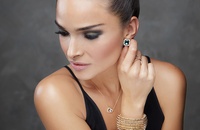
Different types of gemstones have been used for centuries as symbols and icons for just about everything. Ancient Romans wore jewelry with stones believed to carry supernatural healing powers, and the pharaoh-era Egyptians would sometimes bury their dead with turquoise and rubies. Today, gemstones speak more to things like personality, taste, or status. Whether you just want to find a piece to match an outfit or make a personal statement, read this gemstone buying guide to learn about the key things to consider when looking at different types of gemstones.
Precious and Semi-Precious: What’s the Difference?

None, really; the distinction between these terms has more historical significance than anything. The ancient Greeks are generally credited with defining stones as precious or semi-precious. Precious stones were labeled as such because of their rarity—diamonds, rubies, sapphires, and emeralds were hard to come by back then. All other gemstones were considered semi-precious.
Since modern jewelry markets see such a wide breadth of gemstone quality and availability, the terms carry less meaning. While stones like diamonds are certainly still seen as valuable, they don’t always necessarily carry more value than a semi-precious stone. Unique features or a particularly flaw-free makeup can make a semi-precious stone more valuable than its precious brethren.
Lab-Created vs. Simulated Gemstones

While they’re both manmade, the key difference between lab-created and simulated gemstones is their chemical and material makeup. Here are some fast facts on both:
Lab-Created Stones
- Nearly identical to genuine stones; share similar chemical makeup
- Undergo heat, pressure, and mineral interactions in lab conditions
- Takes fraction of the time a genuine stone takes to be made
- Static lab conditions mean fewer inclusions
- Typically, are more affordable than genuine gemstones
Simulated Stones
- Don’t share chemical similarities with genuine stones
- Also made in labs
- Created with materials such as glass or plastic
- Sometimes are supplemented with metals like aluminum to add shine
- Common examples: cubic zirconia, Swarovski crystals, and rhinestones
- Typically, are more affordable than genuine gemstones
What to Look for in a Gemstone
Carat Weight
The weight of a gemstone, like diamonds, is measured in carats. As with diamonds, 1 carat is equal to 0.2 grams. However, since different gemstones have different densities, two stones of the same physical size can vary in their carat count.
Cut
A gemstone's cut grade measures its reflective qualities, or what consumers generally perceive as brilliance. If light returns out of the gemstone's top, that means it's cut with correct proportions. If light escapes through the bottom or sides, that means it's cut too shallow or deep.

|
Ideal
|
Reflects nearly all of the light that enters the stone. A rare cut that results in exquisite brilliance and sparkle.
|
|
Very Good
|
Reflects most all of the light that enters the stone, resulting in superior brilliance and sparkle.
|
|
Good
|
Reflects a large amount of light that enters the stone, resulting in average brilliance and sparkle.
|
|
Fair
|
Cut allows only some of the light to escape out of the sides or the bottom, resulting in reduced perception of brilliance.
|
|
Poor
|
Cut is deep and narrow or shallow and wide, resulting in most of the light escaping out of the sides or the bottom. Appearance of the stone may seem dull.
|


Clarity and Color: What Looks Best to You Is What’s Most Important
An industry term generally associated with diamonds, clarity also has an impact on a gemstone’s overall look. Clarity isn’t measured the same way it is with diamonds, however. The best way to judge a stone? The eye test—see how it looks under different lighting conditions. If it’s too cloudy or has an almost matte-like look to it, its clarity probably isn’t great. But the bottom line is, if you like it, that’s all that really matters.
Stone color comes down to personal preference even more than clarity, as it’s obviously the main differentiating factor between stones. Whether you choose a deep-red ruby to match a formalwear outfit or a cool-blue sapphire representing your calm demeanor, color simply comes down to taste.
Birthstones
While all gemstone jewelry helps make a statement about your style and personality, perhaps no stone has as significant a personal connection as one’s birthstone. Birthstones vary today from the ones originally set in ancient times, when they were thought to bring about good fortune, health, and other benevolences to their wearers. Check out the table below to find your birthstone and its symbolism/significance.

Related Guides
 Diamond Buying Guide
Diamond Buying GuideUnderstand a diamond's most important characteristics, so you're confident in the quality and value of your selection.












